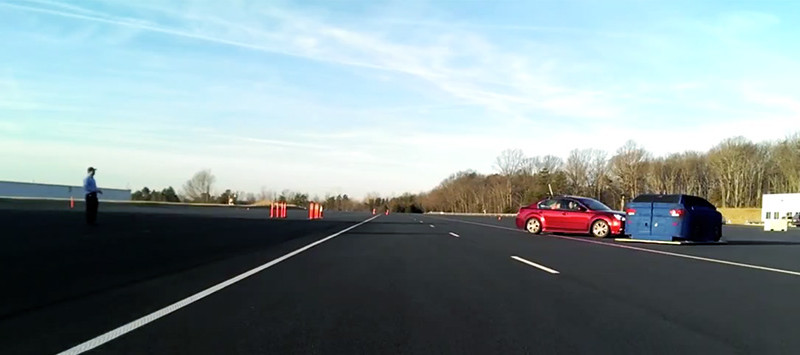The US Insurance Institute for Highway Safety (IIHS) has completed the construction and commissioning of Phase 1 of its state-of-the-art facility at the Vehicle Research Center (VRC) in Virginia. The project is designed to test and compare the effectiveness of new automated collision avoidance systems in cars and SUVs sold in the USA.
The VRC test system, designed and constructed by world-leading autonomous vehicle technology company Perrone Robotics, uses Locata as the sole supplier of high accuracy positioning for both the test and target vehicles. The VRC will depend on Perrone’s advanced vehicle robotics to perform rigorous, consistent and repeatable scientific evaluation of new vehicle crash avoidance systems. This is essential to decide the VRC’s “Top Safety Pick Ratings” that American consumers have depended on for decades to select and buy the safest cars.
On June 4 2014, the VRC, Perrone Robotics and Locata hosted the first public demonstrations at the VRC’s outdoor racetrack testing area. The specially invited audience consisted of engineers, regulators and national policy makers from the US Department of Transport and the US National Highway Traffic Safety Administration. Engineers from the UK, representing the European New Car Assessment Programme which generates the globally recognized 5-star NCAP safety rating system for passenger vehicles, were also in attendance.
Perrone Robotics has developed an in-car kit that can be fitted to any standard vehicle in approximately 30 minutes. The in-car kit autonomously controls and guides the vehicle-under-test around a road circuit, travelling at speeds of up to 50 mph (80 kmph). The vehicle’s collision avoidance systems are tested by directing the car onto a collision course with a target robot carrying a soft foam or plastic model car.
The current VRC Phase 1 LocataNet consists of 8 LocataLites deployed around the test track. It delivers better than 4 cm high-accuracy positioning to Locata receivers in both the vehicle-under-test and the collision target robot. Locata’s positioning technology was chosen by the VRC because of its reliability, accuracy and repeatability – all essential characteristics for a scientific A-B comparison of each manufacturer’s collision avoidance systems. Given the heavily-treed test track surroundings, and the masking of satellite signals by near-by buildings, GPS was not considered sufficiently accurate or reliable for the dynamic test program specified by the VRC.
The VRC is now focused on construction of the Phase 2 area, a 210,000 sq. ft covered Dome building which will simulate indoor car-use areas, such as parking garages. The Locata network will be extended into this indoor area during the commissioning of the Phase 2 test system. GPS does not work very well in these difficult covered or indoor environments, which is just one more reason why Locata was selected as the technology-of-choice for this world-renowned facility. The video below shows highlights from the Phase 1 test track deployment, which has been deemed a great success. Locata now looks forward to completing Phase 2 with Perrone Robotics and the VRC, contributing our positioning technology advances to the development of improved vehicle safety – for the benefit of all drivers on American roads.

